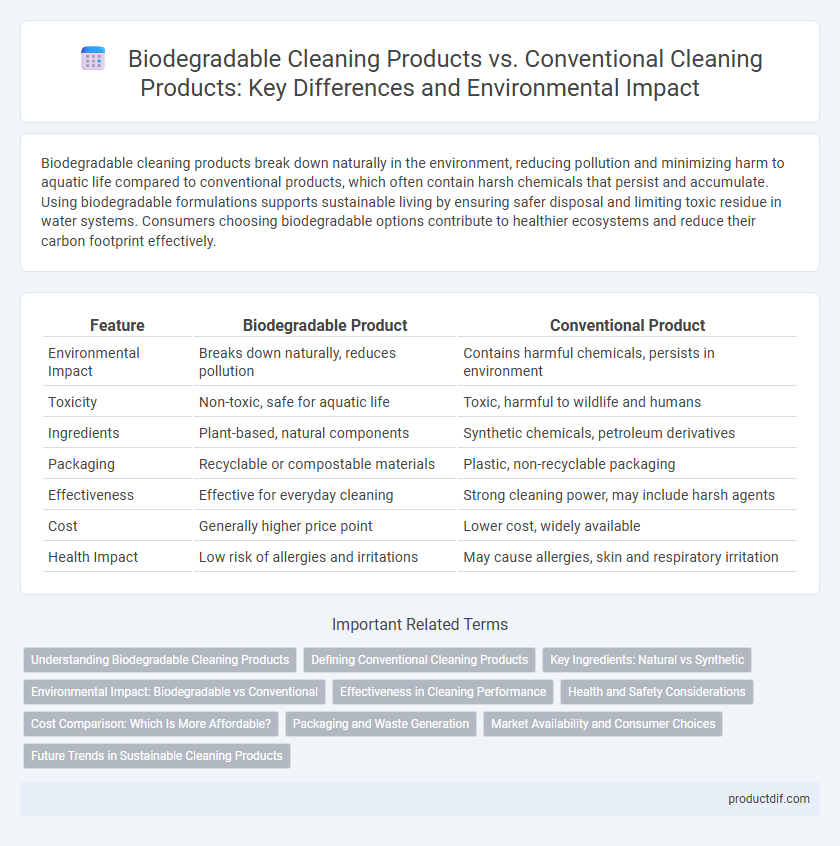Biodegradable cleaning products break down naturally in the environment, reducing pollution and minimizing harm to aquatic life compared to conventional products, which often contain harsh chemicals that persist and accumulate. Using biodegradable formulations supports sustainable living by ensuring safer disposal and limiting toxic residue in water systems. Consumers choosing biodegradable options contribute to healthier ecosystems and reduce their carbon footprint effectively.
Table of Comparison
| Feature | Biodegradable Product | Conventional Product |
|---|---|---|
| Environmental Impact | Breaks down naturally, reduces pollution | Contains harmful chemicals, persists in environment |
| Toxicity | Non-toxic, safe for aquatic life | Toxic, harmful to wildlife and humans |
| Ingredients | Plant-based, natural components | Synthetic chemicals, petroleum derivatives |
| Packaging | Recyclable or compostable materials | Plastic, non-recyclable packaging |
| Effectiveness | Effective for everyday cleaning | Strong cleaning power, may include harsh agents |
| Cost | Generally higher price point | Lower cost, widely available |
| Health Impact | Low risk of allergies and irritations | May cause allergies, skin and respiratory irritation |
Understanding Biodegradable Cleaning Products
Biodegradable cleaning products break down naturally through microbial action, reducing environmental impact compared to conventional products that often contain persistent chemicals. These products are formulated with plant-based ingredients and avoid harmful synthetic additives, promoting safer disposal and less water pollution. Choosing biodegradable cleaners supports sustainability by minimizing toxic residues and enhancing ecosystem health.
Defining Conventional Cleaning Products
Conventional cleaning products typically contain synthetic chemicals such as phosphates, surfactants, and fragrances that can persist in the environment and contribute to pollution. These products often rely on non-renewable resources and may release harmful substances during manufacturing and disposal. Their formulation prioritizes immediate cleaning efficiency over environmental impact, leading to potential health risks and ecological damage.
Key Ingredients: Natural vs Synthetic
Biodegradable cleaning products primarily use natural ingredients such as plant-based surfactants, enzymes, and essential oils that break down easily in the environment, reducing pollution and toxicity. Conventional products typically rely on synthetic chemicals like phosphates, petrochemicals, and artificial fragrances that persist in water systems and contribute to ecological harm. Choosing natural key ingredients in biodegradable formulations supports sustainable cleaning practices and minimizes adverse health and environmental impacts.
Environmental Impact: Biodegradable vs Conventional
Biodegradable cleaning products break down naturally through microbial activity, significantly reducing pollution and minimizing harm to aquatic ecosystems compared to conventional products that contain persistent chemicals. Conventional cleaning products often accumulate in water bodies, leading to toxicity, bioaccumulation, and long-term environmental damage. Choosing biodegradable options supports sustainable waste cycles and decreases the carbon footprint associated with chemical manufacturing and disposal.
Effectiveness in Cleaning Performance
Biodegradable cleaning products often utilize natural enzymes and plant-based surfactants that effectively break down dirt and grease while minimizing environmental impact. Conventional cleaning products typically contain synthetic chemicals that deliver strong, immediate cleaning power but may leave harmful residues and contribute to pollution. Studies indicate biodegradable formulas can match conventional products in cleaning performance, especially when used as directed, providing a sustainable alternative without compromising effectiveness.
Health and Safety Considerations
Biodegradable cleaning products reduce exposure to harmful chemicals by breaking down naturally and minimizing environmental toxins, enhancing indoor air quality and overall health safety. Conventional cleaning products often contain harsh substances like ammonia and chlorine, which can cause respiratory issues, skin irritation, and long-term health risks with prolonged use. Choosing biodegradable options promotes safer handling, less chemical residue, and a lower risk of allergic reactions or toxic buildup in households and workplaces.
Cost Comparison: Which Is More Affordable?
Biodegradable cleaning products often have higher upfront costs due to sustainable ingredients and eco-friendly packaging, whereas conventional products are typically cheaper because of mass production and synthetic components. Over time, using biodegradable products can reduce expenses related to environmental fines and waste disposal, potentially balancing the initial price difference. Consumers prioritizing affordability may initially choose conventional products, but long-term economic benefits favor biodegradable options.
Packaging and Waste Generation
Biodegradable cleaning products often feature packaging made from recycled or compostable materials, significantly reducing landfill waste compared to conventional products that rely on non-recyclable plastics. Conventional cleaning products generate higher volumes of persistent waste due to plastic containers that degrade slowly, contributing to long-term environmental pollution. Choosing biodegradable packaging minimizes ecological impact by promoting faster decomposition and reducing plastic accumulation in waste streams.
Market Availability and Consumer Choices
Biodegradable cleaning products are increasingly available in mainstream retail stores, appealing to environmentally conscious consumers seeking sustainable alternatives to conventional products. Market trends indicate a growing demand for eco-friendly formulations, reflecting heightened awareness of environmental impact and health benefits. Despite this, conventional cleaning products remain prevalent due to their established market presence and perceived effectiveness, influencing consumer choices based on price and performance considerations.
Future Trends in Sustainable Cleaning Products
Biodegradable cleaning products are gaining traction due to increasing consumer demand for eco-friendly solutions that minimize environmental impact and reduce plastic pollution. Future trends emphasize the development of plant-based ingredients, zero-waste packaging, and enhanced efficacy through biotechnology innovations, positioning biodegradable products as the preferred choice over conventional chemical detergents. Advances in green formulation technology and regulatory incentives are further accelerating the shift toward sustainable cleaning alternatives in residential and commercial markets.
Biodegradable Product vs Conventional Product Infographic

 productdif.com
productdif.com